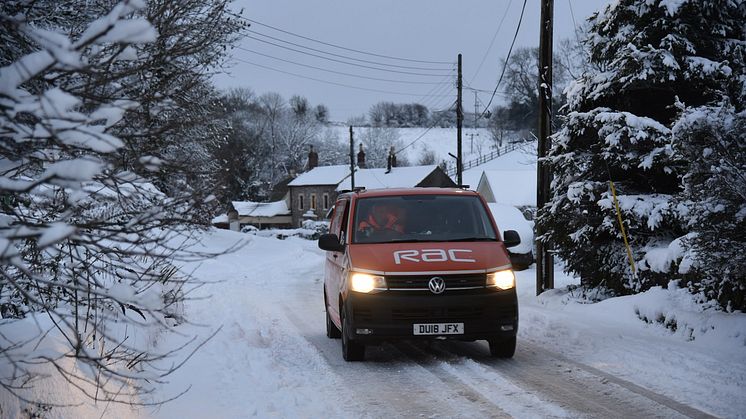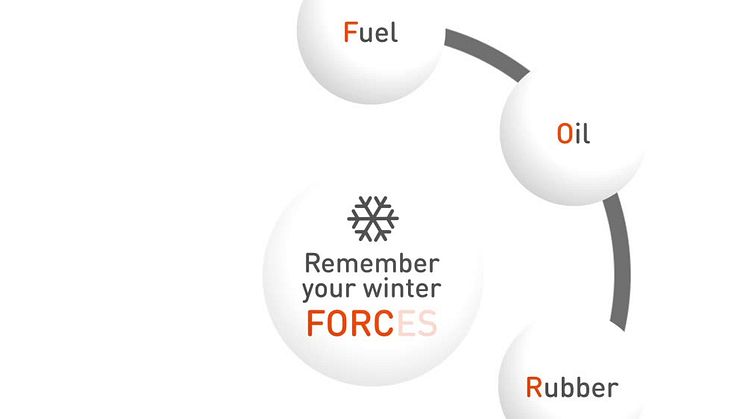
Press release -
British drivers unprepared for winter weather breakdowns
- Car owners are more likely to carry an umbrella than basic safety equipment
- 62% of car owners have broken down in their lifetime
- NFU Mutual and RAC partner to provide advice to drivers
Having surveyed more than 1,500 UK car owners on their ability to cope with a winter breakdown with worrying findings, a rural insurance company is urging drivers to prioritise in-car safety equipment.
The research by the motor insurer and rural specialist NFU Mutual, showed that a huge 62% of car owners have broken down in their lifetime - that’s nearly 21 million breakdowns, given an estimated 33.6 million people drive in the UK.
Given their experience, it’s perhaps understandable that 78% of car owners choose to have breakdown cover, ensuring a rescue service if stranded.
However, a concerning number of drivers could still find themselves in a dangerous situation as the research reveals they are more likely to carry an umbrella than basic emergency safety equipment.
Shockingly, the research showed only one in five car owners keep a warm blanket or warm clothes handy, putting themselves and their families at risk of hypothermia if breaking down in freezing weather.
While half of the car owners won’t set off on a journey without an umbrella, they are also much more likely to keep chewing gum and mints in their vehicle than safety items such as red reflective warning triangles, high visibility jackets or jump leads.
The research showed that women are particularly vulnerable as they are less likely than men to keep most safety items in their car.
Aleks Corr, Motor Insurance Specialist at NFU Mutual, said:
“It’s great that the majority of drivers have a rescue service in place, with a whopping 78% of UK car owners choosing to have breakdown cover. But when you scratch under the surface, drivers are unprepared for the call-out itself, which is a particular risk in the dark, cold weather and even more so if breaking down on isolated and unlit rural roads.
“While brollies might be among the essentials for daily British life, don’t forget the safety fundamentals such as a torch, blanket and a spare tyre to prepare for a breakdown. Keeping basic safety equipment in your car could spell the difference between a minor inconvenience and a traumatically freezing and potentially hazardous family event.
“While technology can be a real lifeline, don’t completely rely on it. Poor signal or a low battery may mean it lets you down when you need it most. Always keep an in-car charger handy, but also equip yourself with analogue alternatives including a road atlas and your breakdown service number written on a piece of paper. Familiarise yourself with safety tips and what to do in an incident, such as how to park safely or how to find an SOS phone on the motorway.”
Breakdown causes and ability to react
According to the RAC, wheel changes are the most common cause of breakdown after battery problems. So it’s alarming to find 36% of drivers don’t have a spare tyre in their car and a further half don’t know how to change one (49%), rendering them stranded and potentially in danger in the case of a blow-out. Road traffic accidents, engine management issues with modern computer-led vehicles and PNS (puncture, no spare) are also cited by the RAC as the main reasons for breakdowns.
NFU Mutual’s research found nearly three quarters (72%) don’t know what to do if their car overheats and only a third (36%) know what the arrows on the motorway (which lead towards an SOS phone each mile) mean. Only half (52%) of car owners know what to use a red warning triangle for and only 26% have one. Britain is the only country in the EU that does not stipulate mandatory use of warning triangles if breaking down.
At NFU Mutual, breakdown cover from RAC is included in its car insurance policy as standard.
Aleks continued: “With NFU Mutual, RAC Mutual Assist breakdown cover comes as part of our car policy as standard, so you don’t need to worry about it. We’re also a Which? Recommended Provider for Car Insurance and our cover is rated 5 star by independent research company, Defaqto.”
Top five safety tips from the RAC
The RAC recommends drivers remember their winter ‘FORCES’. Checking these before a journey can dramatically cut the chances of a breakdown:
- F is for FUEL - Ensure you have enough fuel for your journey. Cars use more fuel in heavy traffic and start/stop conditions
- O is for OIL - To avoid engine damage and a potential breakdown, remember to check your oil level and top up when necessary
- R is for RUBBER – Check tyres have plenty of tread and are inflated properly – and don’t forget to check windscreen wiper blades are clearing screens effectively
- C is for COOLANT - Make sure it's at your vehicle manufacturer's recommended levels – if not, get it checked at a reputable garage
- E is for ELECTRICS - Check all your lights are working correctly including your indicators, brake lights and fog lights - and replace any faulty bulbs or blown fuses
- S is for SCREENWASH - Top-up your windscreen washer fluid by using a good quality screenwash which is effective down to very cold temperatures. Remember that colder conditions demand a more concentrated solution
NFU Mutual’s advice
NFU Mutual advises on items to carry in your vehicle, packaged in waterproof bag to protect against flooding:
- Warm blanket, warm clothes handy and waterproofs
- Non-perishable food and water
- Red reflective warning triangles
- High visibility jackets
- Jump leads
- Torch
- Sunglasses
- A spare tyre and jack
- Road atlas
- Breakdown service number written on a piece of paper
- In-car charger
- First aid kit
- Ice scraper / de-icing kit
Topics
Categories
Notes to Editors
Top items which car owners permanently keep in their car, according to the research:
| Place | Item | % of drivers who keep item in car |
| 1 | Spare tyre | 64% |
| 2 | De-icer / scraper | 63% |
| 3 | Carrier bags | 56% |
| 4 | Sunglasses | 52% |
| 5 | Umbrella | 50% |
| 6 | Breakdown service number | 43% |
| 7 | In-car phone charger | 43% |
| 8 | Loose change | 40% |
| 9 | First aid kit | 39% |
| 10 | Road atlas | 31% |
| 11 | Chewing gum/mints | 30% |
| 12 | Torch | 30% |
| 13 | Windscreen wash | 28% |
| 14 | Car cleaning equipment | 28% |
| 15 | Tools | 28% |
| 16 | Red reflective warning triangle | 26% |
| 17 | High visibility jacket | 24% |
| 18 | Jump-start cables | 23% |
| 19 | Warm clothes/blankets | 21% |
| 20 | Oil | 16% |
- NFU Mutual research - Populus conducted an online sample of 2,000 UK adults 18+ between 11th and 13th October 2019. Data is weighted to be representative of the population of Great Britain. Targets for quotas and weights are taken from the National Readership Survey, a random probability F2F survey conducted annually with 34,000 adults. Populus is a founder member of the British Polling Council and abides by it rules.
- Further statistics according to the NFU Mutual research:
- Statistically, men are more likely to break down than women at 69% vs. 54%,
- You are also statistically more likely to break down if you live in the South West (74%), Wales (67%) and Northern Ireland (70%). People in the North East are least likely to have ever broken down at just 54%.
- RAC research – RAC analysed breakdown data with its NFU Mutual customers who contacted RAC for a call out between September 2018 and September 2019.
About the RAC
The RAC provides complete peace of mind to 11m UK private and business drivers, whatever their motoring needs. Its services include:
- Breakdown assistance. Its highly-skilled, 1,600-strong branded patrol workforce attends more than two million breakdowns every year, fixing on average four out of five vehicles at the roadside. The RAC’s patrol fleet is one of the most advanced in the world, and was the first to roll out both an All-Wheels-Up recovery system, allowing the vast majority of vehicles to be recovered from a single patrol van, and EV Boost mobile electric vehicle charging units
- Insurance. The RAC is a top-five car insurance broker having surpassed the 500,000 policies-in-force milestone in 2018. It also offers ‘black box’ telematics policies, as well as home and travel insurance
- Other motoring services. The RAC leads in the development of new solutions for business, fleets, electric vehicles and future car technology. Its additional products and services include a personal loans offering, a used car buying website, vehicle inspections and checks, legal services or up-to-the-minute traffic and travel information. It also has a network of Approved Dealers and Approved Garages which combine the trust of RAC brand with local service and convenience
The RAC also works to support the interests of its members and UK drivers on the most important motoring issues which it identifies via the annual RAC Report on Motoring and the RAC Opinion Panel. The Report on Motoring is the longest running analysis of driver opinion in the UK having been published every year since 1989.
For more information about the RAC, visit the RAC website.


